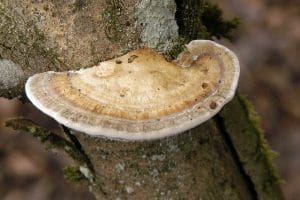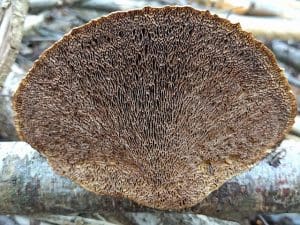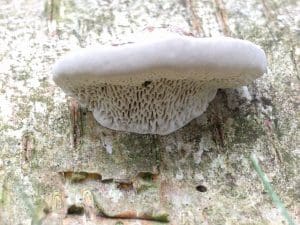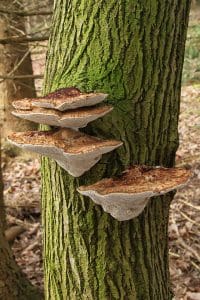Blushing Bracket / Spring / Summer / Autumn / Winter / Inedible
The Blushing Bracket (Daedaleopsis confragosa) is a fascinating and attractive polypore mushroom that has unique coloration and intricate patterns. Commonly found on decaying hardwood trees and fallen branches across Europe and North America, this mushroom is renowned for its characteristic “blushing” reaction when the surface is touched or damaged, turning from white to shades of pink or red.
The Blushing Bracket features a semicircular, bracket-like cap with concentric zones of varying colours and a maze-like pattern of pores on the underside.
In this blog post, we’ll explore the key identifying features of the Blushing Bracket, its ecological role in woodland environments, and tips for spotting this remarkable mushroom during your forest adventures.
Scientific Name
Daedaleopsis confragosa
Common Names
Blushing Bracket, Thin walled maze polypore
Family
Fomitopsidaceae
Habitat
They are a parasite and they cause a white rot in injured hardwoods, especially willows.
Description
It is a tough, slow-growing fungus that is most commonly seen growing in tiers.
Identifying Features:
Cap:
The fruit bodies are semicircular and tough, the brownish upper surface is concentrically zoned and they can measure up to 20 cm in diameter and about 2 cm thick. The whitish underside turns gray-brown as the fruit body ages, but bruises pink or red when handled. They lack a stalk and attach directly to the host tree.
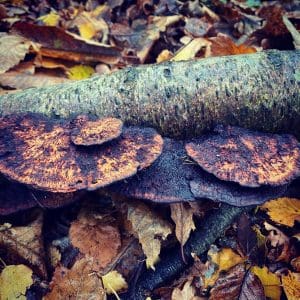
Tubes or Pores:
The under surface is covered in tiny holes or pores. The pores shape can vary from circular to maze like, to gill-like. They are white to grey when young but will discolour pink to red when handled.
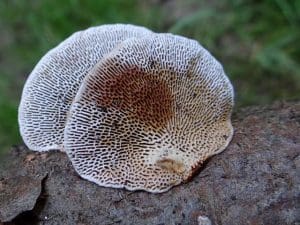
Smell:
No distinct smell.
Spores:
White.
Uses:
While not thought to be toxic, they are tough and inedible.
However they have been the subject of recent medical research looking at their antifungal, antioxidative, and genoprotective properties.
Known hazards
No known hazards.
Potential lookalikes:
They could be confused with some of the Mazegill brackets such as the Oak Mazegill (Daedalea quercina) but the Oak Mazegill pores are all in the form of a maze. It also doesn’t bruise red when handled.
Lets look at some others
- Turkey Tail (Trametes versicolor)
- Appearance: Multicoloured zones on the cap, often displaying shades of brown, white, yellow, and blue.
- Key Differences: The Turkey Tail has a more velvety texture and lacks the blushing reaction when damaged. Its pores are smaller and more uniform compared to the maze-like pattern of the Blushing Bracket.
- Artist’s Bracket (Ganoderma applanatum)
- Appearance: Large, perennial, and woody with a grey to brown upper surface and white pore surface that turns brown when scratched.
- Key Differences: The Artist’s Bracket does not blush when damaged. It is larger and more robust, with a pore surface that can be inscribed, hence the name.
- Maze-gill Fungus (Daedalea quercina)
- Appearance: Similar maze-like pattern of gills on the underside, usually found on oak wood.
- Key Differences: The Maze-gill Fungus has a tougher, more rigid texture and does not exhibit the blushing reaction. It typically grows on oak, whereas the Blushing Bracket can be found on a wider range of hardwoods.
- Hairy Bracket (Trametes hirsuta)
- Appearance: Whitish to grey, with a hairy or fuzzy texture on the cap.
- Key Differences: The Hairy Bracket does not blush when damaged and has a distinctive hairy texture that differentiates it from the smoother surface of the Blushing Bracket.
- False Turkey Tail (Stereum ostrea)
- Appearance: Similar concentric zones of colour, but lacking pores; instead, it has a smooth underside.
- Key Differences: The False Turkey Tail has a smooth, poreless underside and does not blush when touched or damaged. It also tends to be thinner and more flexible compared to the Blushing Bracket.
Extra Notes
They can be pulped and used to make ornamental paper.



